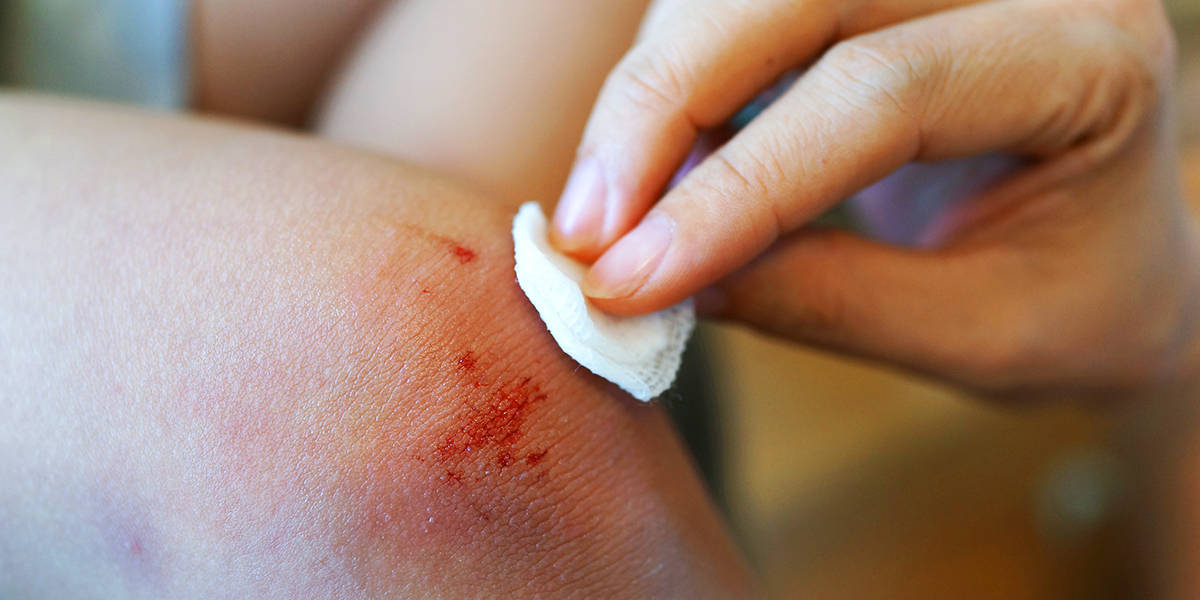
Cleaning a wound prior to applying a plaster or dressing reduces the risk of infection and facilitates the healing process. Caring for a wound properly makes healing happen faster and can prevent scarring.
If you’ve received a cut or you’re tending to a cut on someone else, make you sure carefully clean the wound before applying a dressing or plaster to it.
How to clean a wound

Wounds of any size should always be cleaned and bandaged as soon as possible. If you’re treating another person, tell them what you’re doing and ensure they’re sitting or lying down. Follow these steps:
Step 1: Wash and dry your hands thoroughly
Wash your hands for the length of the “Happy Birthday” song twice (around 40 seconds). If possible, wear disposable gloves while tending to the wound.Step 2: If the wound is bleeding, apply pressure
Gently press down on the wound with a clean cloth or sterile gauze. If the wound is on an arm or a leg, you should raise it above heart level if possible.Step 3: Rinse the wound under clean running water
Run the wound under the tap for 5 to 10 minutes to remove any loose dirt and debris.Step 4: Clean the skin with water or saline solution
Soak a cloth or a gauze pad with water or saline solution—or use an alcohol-free wipe—to clean the skin. Gently dab or wipe, being careful not to irritate the wound. Refrain from using antiseptic, as this may damage the skin.Step 5: Dry the wound and surrounding skin
Gently pat the area dry with tissues or a clean towel. Take care not to use anything fluffy like cotton wool, as strands of material can get stuck inside the wound.Step 6: Apply a plaster or dressing to the wound
Use a sterile dressing like a plaster or a non-adhesive pad with a bandage. If you can, use a waterproof dressing. If blood soaks through the dressing, leave it in place and apply another dressing while continuing to put pressure on the wound.What not to do when cleaning a wound
Refrain from the following when cleaning a wound:- Don’t use alcohol to clean the wound: Using rubbing alcohol to disinfect a wound is a common mistake. Alcohol not only destroys bacteria but also living skin cells and can interfere with the body’s healing process.
- Don’t attempt to remove anything embedded in the wound: Removing an object lodged in the wound can make the situation worse. If you’re dealing with a wound with an object embedded in it, seek medical advice.
When to seek medical advice

Under the following circumstances, always seek medical advice before tending to a wound:
- The wound won’t stop bleeding
- The wound is very deep or very large
- There is a large amount of grit or debris in the wound
- There is an object embedded in the wound
- The wound is near a major blood vessel or joint
- It is too painful to properly clean
- It becomes swollen and red, or there is pus seeping out
- The wound was caused by an animal or human bite
Why is wound cleansing important?
When the skin is broken it leaves the body vulnerable to infection from dirt and bacteria. This causes further skin damage and slows the healing process. If left untreated, minor infections can spread and lead to a more serious health condition. This is why proper wound cleaning is an integral part of wound care and the wound healing process.Read our other blogs for more information on first aid or contact us for further advice and information on our products.
About the author:
Jo Stokes is a writer, marketer and trained first aider at First Aid Online.
Find out more about Jo.
By Jo Stokes

